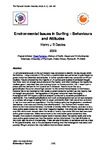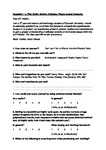Environmental Issues in Surfing - Behaviours and Attitudes
| dc.contributor.author | Davies, H.J.B. | |
| dc.date.accessioned | 2019-05-13T10:28:19Z | |
| dc.date.available | 2019-05-13T10:28:19Z | |
| dc.date.issued | 2009 | |
| dc.identifier.citation |
Davies, H.J.B. (2009) 'Environmental Issues in Surfing - Behaviours and Attitudes', The Plymouth Student Scientist, p. 108-155. | en_US |
| dc.identifier.issn | 1754-2383 | |
| dc.identifier.uri | http://hdl.handle.net/10026.1/13857 | |
| dc.description.abstract |
A comprehensive study of the surf industry was conducted to identify the key issues within the industry. Using a sample of 125 surfers a questionnaire was performed to gain insight on green consumer behaviour and attitudes. A further questionnaire was conducted on 20 surf retailers. Results showed that the majority of UK surfers and retailers interviewed thought that there were not enough eco-products on the market, and when looking at the results the retailers gave it was clear they saw a strong future for the eco-product, that it wasn’t just a phase and that demand in the future is set to increase. Results found that as a generalisation the surfer shows high concern for the environmental issues in the industry, however this is not matched by their levels of green consumer activism as the majority had not bought eco-products. Demographics of the green consumer were thoroughly investigated with Chi-square statistical analysis conducted to establish probabilities of relationship. The marketing implications from such an investigation can put an eco-company at a serious advantage, enabling them to target and identify their main customers and even to ‘tap’ into new customer populations. The key findings were that longboarders considered themselves to be more eco-friendly than shortboarders. The ‘Surfers Path’ readers were shown to be more concerned about the levels of toxicity within the industry, and also to be a more active green consumer, than other magazine readers. The other key findings were that over 30’s show more concern about the levels of toxicity than under 30’s and also are more active green consumers. Males were shown to be more active green consumers than females. Non-students showed a higher level of concern about the toxicity levels and to be more active green consumers than the student surfers interviewed. The main limitation to this study was the size of the samples. There are also limitations to technique such as a bias in the questionnaires, due to the participants knowing what the investigation was about and possibly filling in answers that they believe the interviewer desired. | en_US |
| dc.language.iso | en | en_US |
| dc.publisher | University of Plymouth | |
| dc.rights | Attribution 3.0 United States | * |
| dc.rights.uri | http://creativecommons.org/licenses/by/3.0/us/ | * |
| dc.subject | surf | en_US |
| dc.subject | surfers | en_US |
| dc.subject | UK | en_US |
| dc.subject | green consumer | en_US |
| dc.subject | eco-product | en_US |
| dc.subject | toxicity | en_US |
| dc.subject | environment | en_US |
| dc.subject | marine | en_US |
| dc.subject | environmental | en_US |
| dc.subject | behaviours | en_US |
| dc.subject | attitudes | en_US |
| dc.title | Environmental Issues in Surfing - Behaviours and Attitudes | en_US |
| dc.type | Article | |
| plymouth.issue | 1 | |
| plymouth.volume | 2 | |
| plymouth.journal | The Plymouth Student Scientist |




